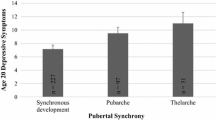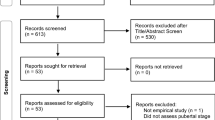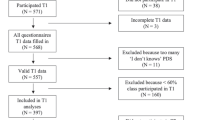Abstract
Individual differences in the timing and tempo of pubertal development have been shown to be related to depressive symptoms during adolescence, particularly among girls. Another measure of variability in pubertal development is pubertal synchrony, the degree to which the development of pubertal indicators (e.g., breast growth and ancillary hair growth) are synchronized within the individual. Pubertal synchrony also has been hypothesized to be related to depressive symptoms, but, to date, only one study has tested this hypothesis. However, it remains unclear whether pubertal synchrony confers risk for depressive symptoms more proximally in time or differentially among boys or non-White youth. The current study examined the relation between pubertal synchrony and depressive symptoms concurrently and six months later as a function of race and sex in a community sample of 215 youth (53% female, 44.7% African American; mean age = 12.90 years (SD = 0.86)). Girls with asynchronous development at Time 1 reported significantly higher depressive symptoms at Time 2 than girls with synchronous development and boys with asynchronous development. In addition, boys with asynchronous development at Time 1 had lower depressive symptoms at Time 2 than boys with synchronous development. Race did not moderate pubertal synchrony—depression relations. These results suggest that pubertal asynchrony is a risk factor for girls, but a protective factor for boys, and lend support for pubertal synchrony as a potential contributor to the gender gap in depression that emerges during adolescence.

Similar content being viewed by others
References
Aksglaede, L., Sørensen, K., Petersen, J. H., Skakkebæk, N. E., & Juul, A. (2009). Recent decline in age at breast development: the Copenhagen Puberty Study. Pediatrics, 123, e932–e939.
Alloy, L. B., Black, S. K., Young, M. E., Goldstein, K. E., Shapero, B. G., Stange, J. P., & Abramson, L. Y. (2012). Cognitive vulnerabilities and depression versus other psychopathology symptoms and diagnoses in early adolescence. Journal of Clinical Child & Adolescent Psychology, 41, 539–560.
Alloy, L. B., Hamilton, J. L., Hamlat, E. J., & Abramson, L. Y. (2016). Pubertal development, emotion regulatory styles, and the emergence of sex differences in internalizing disorders and symptoms in adolescence. Clinical Psychological Science, 4, 867–881.
Bailey, R. K., Mokonogho, J., & Kumar, A. (2019). Racial and ethnic differences in depression: current perspectives. Neuropsychiatric Disease and Treatment, 15, 603–609.
Biro, F. M., Lucky, A. W., Simbartl, L. A., Barton, B. A., Daniels, S. R., Striegel-Moore, R., & Morrison, J. A. (2003). Pubertal maturation in girls and the relationship to anthropometric changes: pathways through puberty. The Journal of Pediatrics, 142, 643–647.
Brooks-Gunn, J., & Warren, M. P. (1985). The effects of delayed menarche in different contexts: dance and nondance students. Journal of Youth and Adolescence, 14, 285–300.
Conley, C. S., & Rudolph, K. D. (2009). The emerging sex difference in adolescent depression: interacting contributions of puberty and peer stress. Development and Psychopathology, 21, 593–620.
Eichorn, D. H. (1975). Asynchronizations in adolescent development. In S. E. Dragastin, & G. H. Elder (eds), Adolescence in the Life Cycle. Washington. D.C.: Hemisphere.
Gaylord‐Harden, N. K., Burrow, A. L., & Cunningham, J. A. (2012). A cultural‐asset framework for investigating successful adaptation to stress in African American youth. Child Development Perspectives, 6, 264–271.
Ge, X., Brody, G. H., Conger, R. D., Simons, R. L., & Murry, V. M. (2002). Contextual amplification of pubertal transition effects on deviant peer affiliation and externalizing behavior among African American children. Developmental Psychology, 38, 42.
Graber, J. A., Seeley, J. R., Brooks-Gunn, J., & Lewinsohn, P. M. (2004). Is pubertal timing associated with psychopathology in young adulthood? Journal of the American Academy of Child & Adolescent Psychiatry, 43, 718–726.
Grumbach, M. M. (2002). The neuroendocrinology of human puberty revisited. Hormone Research in Paediatrics, 57, 2–14.
Hankin, B. L., & Abramson, L. Y. (2001). Development of gender differences in depression: an elaborated cognitive vulnerability–transactional stress theory. Psychological Bulletin, 127, 773.
Hayward, C., Gotlib, I. H., Schraedley, P. K., & Litt, I. F. (1999). Ethnic differences in the association between pubertal status and symptoms of depression in adolescent girls. The Journal of Adolescent Health, 25, 143–149.
Keenan, K., Culbert, K. M., Grimm, K. J., Hipwell, A. E., & Stepp, S. D. (2014). Timing and tempo: exploring the complex association between pubertal development and depression in African American and European American girls. Journal of Abnormal Psychology, 123, 725.
Kong, G., Smith, A. E., McMahon, T. J., Cavallo, D. A., Schepis, T. S., Desai, R. A., & Krishnan-Sarin, S. (2013). Pubertal status, sensation-seeking, impulsivity, and substance use in high-school-aged boys and girls. Journal of Addiction Medicine, 7, 116.
Kovacs, M. (1985). The Children’s Depression Inventory (CDI). Psychopharmacology Bulletin, 21, 995–998.
Lee, P. A., Guo, S. S., & Kulin, H. E. (2001). Age of puberty: data from the United States of America. APMIS, 109, S156–S163.
Masip, A. F., Amador-Campos, J. A., Gómez-Benito, J., & del Barrio Gándara, V. (2010). Psychometric properties of the children’s depression inventory in community and clinical sample. The Spanish Journal of Psychology, 13, 990–999.
Mendle, J. (2014). Beyond pubertal timing: new directions for studying individual differences in development. Current Directions in Psychological Science, 23, 215–219.
Mendle, J., Harden, K. P., Brooks-Gunn, J., & Graber, J. A. (2010). Development’s tortoise and hare: pubertal timing, pubertal tempo, and depressive symptoms in boys and girls. Developmental Psychology, 46, 1341.
Mojtabai, R., Olfson, M., & Han, B. (2016). National trends in the prevalence and treatment of depression in adolescents and young adults. Pediatrics, 138, e20161878.
Mouritsen, A., Aksglaede, L., Soerensen, K., Hagen, C. P., Petersen, J. H., Main, K. M., & Juul, A. (2013). The pubertal transition in 179 healthy Danish children: associations between pubarche, adrenarche, gonadarche, and body composition. European Journal of Endocrinology, 168, 129–136.
Mrug, S., King, V., & Windle, M. (2016). Brief report: explaining differences in depressive symptoms between African American and European American adolescents. Journal of Adolescence, 46, 25–29.
Novotny, R., Daida, Y., Morimoto, Y., Shepherd, J., & Maskarinec, G. (2011). Puberty, body fat, and breast density in girls of several ethnic groups. American Journal of Human Biology, 23, 359–365.
Obeidallah, D. A., Brennan, R. T., Brooks-Gunn, J., Kindlon, D., & Earls, F. (2000). Socioeconomic status, race, and girls’ pubertal maturation: results from the project on human development in Chicago neighborhoods. Journal of Research on Adolescence, 10, 443–464.
Petersen, A. C., Crockett, L., Richards, M., & Boxer, A. (1988). A self-report measure of pubertal status: reliability, validity, and initial norms. Journal of Youth and Adolescence, 17, 117–133.
Saenger, P., & Dimartino-Nardi, J. (2001). Premature adrenarche. Journal of Endocrinological Investigation, 24, 724–733.
Saylor, C. F., Finch, A. J., Spirito, A., & Bennett, B. (1984). The Children’s Depression Inventory: a systematic evaluation of psychometric properties. Journal of Consulting and Clinical Psychology, 52, 955–967.
Shirtcliff, E. A., Dahl, R. E., & Pollak, S. D. (2009). Pubertal development: correspondence between hormonal and physical development. Child Development, 80, 327–337.
Susman, E. J., Houts, R. M., Steinberg, L., Belsky, J., Cauffman, E., DeHart, G., & Halpern-Felsher, B. L. (2010). Longitudinal development of secondary sexual characteristics in girls and boys between ages 9½ and 15½ years. Archives of Pediatrics & Adolescent Medicine, 164, 166–173.
Thompson, S. M., Hammen, C., & Brennan, P. A. (2016). The impact of asynchronous pubertal development on depressive symptoms in adolescence and emerging adulthood among females. Journal of Youth and Adolescence, 45, 494–504.
Author information
Authors and Affiliations
Contributions
A.S. generated hypotheses, created the database, ran and interpreted data analysis, and drafted the paper; A.A.G. helped generate hypotheses, and helped draft the paper; L.Y.A. provided feedback on the paper; L.B.A. helped design the original study and write the grant that funded the study, participated in the design and coordination of this study, and provided feedback on all drafts of the paper. All authors read and approved the final paper.
Funding
This research was supported by National Institute of Mental Health Grants MH101168 and MH079369 to L.B.A.
Data Sharing and Declaration
The datasets generated and/or analyzed during the current study are not publicly available but may be available from the corresponding author on reasonable request.
Corresponding author
Ethics declarations
Conflict of Interest
The authors declare that they have no conflict of interest.
Ethical Approval
The Temple University Institutional Review Board approved the protocol (IRB protocol #6844).
Informed Consent
Written informed consent was collected from all study participants after explaining their role in the study and before starting data collection.
Additional information
Publisher’s note Springer Nature remains neutral with regard to jurisdictional claims in published maps and institutional affiliations.
Rights and permissions
About this article
Cite this article
Stumper, A., Graham, A.A., Abramson, L.Y. et al. Pubertal Synchrony and Depressive Symptoms: Differences by Race and Sex. J Youth Adolescence 49, 2275–2284 (2020). https://doi.org/10.1007/s10964-020-01314-x
Received:
Accepted:
Published:
Issue Date:
DOI: https://doi.org/10.1007/s10964-020-01314-x




